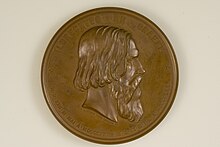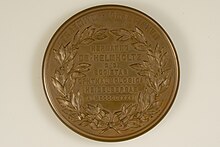Graefe Medal
The Graefe Medal is an honor for special services to ophthalmology .
Award
The foundation of this science medal was decided in 1874 by the "Ophthalmological Society Heidelberg", today's German Ophthalmological Society (DOG) in memory of its founder Albrecht von Graefe . It is the society's highest scientific award.
According to its statute , it is to be awarded “every ten years to those who among contemporaries - regardless of nationality - have made the greatest contribution to the promotion of ophthalmology .” The general assembly elects the award winner on the recommendation of a separately elected person nine-member commission . The medal will then be presented in a ceremony during the following annual meeting.
medal
The obverse shows the ideal portrait of Albrecht von Graefe in profile as well as his name and his life dates in inscription. Below the neck section is the signature “F. Hartzer ”and attached to it the numismatic abbreviation “ FEC. ” ( Latin fecit , 'has (it) made' ), which Ferdinand Hartzer , a Berlin sculptor, identifies as a“ designer ”. This is followed by the name “E. Weigand ”- this is probably the medalist , Emil Weigand from Berlin . The addition "SC." ( Latin sculpsit , has (it) stung ' ) suggests this.
On the reverse are seven lines centered in a laurel wreath , the name of the honoree, the company's name and the year of the ceremony marked . The information on both sides is in Latin and script or in Roman numerals .
The coin has a diameter of around 70 mm and is made in bronze , presumably also in silver, and as a single copy for the prize winner in gold in a previously unpublished edition . A case comes with the medal .
Handwritten information on the invitation to tender, the first drafts and a plaster cast of the Graefe Medal can be found in the Albrecht von Graefe Collection in the Berlin Medical History Museum of the Charité .
history
The Graefe Medal was first awarded twelve years late. Because it was not until 1884 that the foundation fund was provided with sufficient financial resources and negotiations on the design of the medal could be started with Hetzer. The medal was then completed in 1886, the year it was first awarded. On August 9th, Franciscus Cornelis Donders ceremoniously presented Hermann von Helmholtz with the first edition of the Graefe Medal in gold .
After that, the foundation ran into difficulties several times, not only with regard to compliance with the ten-year cycle : in 1916, in the middle of the First World War , no medal could be awarded for the first time. Then the inflation of 1923 almost completely devalued the foundation fund. Only a generous donation from American member Otto Barkan saved the foundation.
In the years that followed, the political situation was aggravated by the fact that members and committees were divided and found it difficult to agree on candidates. So were Anton ELSCHNIG to describe the ELSCHNIG syndrome , Ernst Fuchs for Fuchs' dystrophy and Karl Koller , the founder of local anesthesia in ophthalmology , the Graefe Medal denied.
In the post-war year 1948, organizing a DOG meeting and awarding an award was out of the question, and it was not until 1957 that the DOG was awarded a medal again for the 100th anniversary of its existence. The statute was last amended in 1964.
In the literature the incorrect designations "von Graefe-Medaille" or "Albrecht-von-Graefe-Medaille der DOG" can be found. The Graefe Medal is also not identical to the von Graefeschen Prize of the DOG (meanwhile: von Graefe Prize ) or the Albrecht von Graefe Medal , which has been awarded by the Berlin Medical Society since 1980 .
List of award winners
- 1886: Hermann von Helmholtz a . a. for the invention of the ophthalmoscope
- 1896: Theodor Leber for research on the pathological anatomy and histology of the eye
- 1900: Carl von Heß
- 1906: Ewald Hering for his main work The Doctrine of Binocular Vision
- 1928: Allvar Gullstrand, among other things, for the development of the slit lamp , which made "microscopy of the living eye" possible
- 1938: Jules Gonin ( posthumously ) for services to the surgical therapy of retinal detachment
- 1957: Rudolf Thiel for services to research into glaucoma
- 1965: Hans Goldmann for a variety of inventions, such as B. the applanation tonometer , the contour perimeter or the three-mirror contact lens
- 1976: Jules François among others for his scientific work and his services to international ophthalmology
- 1986: Gerhard Meyer-Schwickerath for the establishment of photocoagulation , which is the basis of modern laser photocoagulation was
- 1996: Franz Fankhauser for basic research on computer-controlled static perimetry
- 2006: Gottfried OH Naumann for his services to international ophthalmology
- 2016: Eberhart Zrenner for his basic research, which u. a. resulted in the development of the retina implant
Web links
- All award winners since 1876 , on the website of the German Ophthalmological Society, accessed on December 8, 2017
Individual evidence
- ↑ a b c Hermann Helmholtz's Graefe Medal in the coin and medal collection of the Bergen Museum on the Norwegian Museums' UNIMUS website , unimus.no, accessed on January 3, 2015
- ↑ a b by Graefe; Ingo presentation of the first von Graefe medal and letters from Albrecht von Graefes by Dr. Ingo von Graefe (great-grandson of Albrecht von Graefe) in: Greetings for the ceremony for the DOG 2007 meeting ( dog.org PDF, 650 KB ), accessed on January 3, 2015
- ↑ a b c statute concerning the granting and awarding of Graefe-Medallion in ( general meeting of the German Ophthalmological incorporated 1964 . (PDF): . Springer.com S. 452 et seq. , Accessed on August 20, 2019 . )
- ↑ a b Hirschberg, Julius : History of Ophthalmology P. 248 f. Full text / preview in Google Book Search
- ↑ plaques, coins and medals , rzuser.uni-heidelberg.de, accessed on January 3, 2015
- ^ Ophthalmology- historical Albrecht von Graefe Collection in the Berlin Medical History Museum of the Charité , bmm-charite.de, accessed on January 14, 2015
- ↑ a b c d German Ophthalmological Society (ed.): Visus and vision 150 years of DOG. Festschrift for the 150th anniversary of the German Ophthalmological Society , Munich 2009 ( dog.org PDF, 29.6 MB ), accessed on January 3, 2015
- ↑ Hermann von Helmholtz's answer: delivered at the reception of the Graefe Medal in Heidelberg on August 9, 1886. Retrieved on August 20, 2019 .
- ↑ Hering, Ewald: The teaching of binocular vision , Leipzig 1886 (full text, full search as digitized version).
- ↑ Keynote Lecture Saturday - DOG2016. In: dog2016.dog-kongress.de. Retrieved February 5, 2016 .

